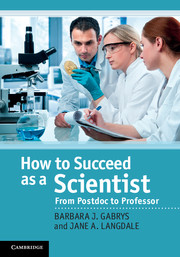Book contents
- Frontmatter
- Contents
- Preface
- Acknowledgements
- Part I Becoming an independent researcher
- Part II Thriving in your new job
- 10 Handling new roles
- 11 Learning from other people
- 12 Managing people
- 13 Building a research group I
- 14 Building a research group II
- 15 Interacting with others
- 16 Designing a taught course
- 17 Giving a good lecture
- 18 Beyond lecturing
- 19 Mentoring
- Part III Managing your career
- Index
- References
17 - Giving a good lecture
from Part II - Thriving in your new job
Published online by Cambridge University Press: 05 November 2011
- Frontmatter
- Contents
- Preface
- Acknowledgements
- Part I Becoming an independent researcher
- Part II Thriving in your new job
- 10 Handling new roles
- 11 Learning from other people
- 12 Managing people
- 13 Building a research group I
- 14 Building a research group II
- 15 Interacting with others
- 16 Designing a taught course
- 17 Giving a good lecture
- 18 Beyond lecturing
- 19 Mentoring
- Part III Managing your career
- Index
- References
Summary
When designing and delivering a good lecture, the same principles hold as for delivering a research seminar (see Chapter 2). However, you also need to consider how to enable effective learning. In this chapter we provide practical advice on how to maximise student learning from lectures.
The theory
Everybody recognises good teaching intuitively, and its qualifying characteristics have been confirmed by educational research. In words attributed to Richard Feynman, one of the greatest physicists and a gifted teacher: ‘There are two types of scientists – one says look how clever I am and the other says look how simple it is’ (Leighton & Feynman, 1992). Obviously, the latter has a much better chance of engaging students. Such an attitude reflects the teacher’s enthusiasm for the subject, and also a willingness to work hard to make the subject matter accessible. But how does this teaching attitude translate into effective lecturing?
Since the Middle Ages, lecturing has been one of the principal methods of ‘knowledge transfer’ to students at universities (Bligh, 1998). Its prominent place in mathematical, physical and life sciences is implicitly acknowledged and it is seen as the core method, to be complemented by tutorials, classes, laboratories and fieldwork where appropriate. But what is the purpose of a lecture? Lectures are most effective when they are used to deliver new information, provide an overview of a subject or to weave together several ideas from different sources. A more mundane use is to explain key concepts in detail or to guide students through detailed calculations.
Information
- Type
- Chapter
- Information
- How to Succeed as a ScientistFrom Postdoc to Professor, pp. 155 - 161Publisher: Cambridge University PressPrint publication year: 2011
